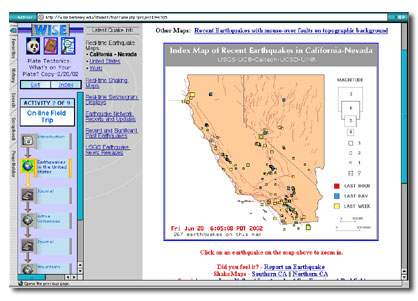Research Goals and Outcomes | Research Design | Results
Research Goals and Outcomes
There are two sets of research questions for the MTV project. They are centered around two WISE pedagogical frameworks, namely, Making Thinking Visible, and Help Students Learn From One Another.
Make Thinking Visible. Here, we extend the notion of "making thinking visible" to utilize visual modes of representation in two ways. First, we engage students in drawing tasks to make their models explicit and use these as knowledge artifacts for both model revision as well as collaborative discourse. Second, we provide students with a set of dynamic, runnable models of plate tectonic phenomena. Here, students use the runnable prototypes to visualize dynamic, causal, and temporal processes in order to test, critique, and revise their own models. WISE prompts students to justify and explain their changes in order to reify learning. Prompts include: "What does your new model include that it didn't before?", and "What does your new model describe or explain that it didn't before?"
 Research questions around this pedagogical framework are:
Research questions around this pedagogical framework are:
- In what ways does model-building in WISE promote a deeper understanding of content knowledge in plate tectonics?
- In what ways do students' on-line critique of their peers' models influence model revision?
- In what ways does learning with dynamic runnable visual models in WISE promote a deeper understanding of content knowledge in plate tectonics?
- In what ways do these modeling activities in WISE influence students' epistemologies about the nature of scientific models?
Other issues being addressed around this pedagogical framework include findings about students' learning with respect to: model-based reasoning, the affordances made by "visualizing" and insight into how these processes may be different from conventional pencil and paper model-based tasks.
In MTV we also seek to promote students' knowledge integration by Helping Students Learn from One Another. The goal here is to promote students' inquiry and knowledge integration by having students engage in discourse while addressing intriguing questions that are personally relevant. We do this in two ways: First, we engage students in discourse about the evolution of the theory of plate tectonics. The goal here is to promote both understanding about the evolution of Plate Tectonics as well as epistemological understanding of how scientific theories are developed and changed, how theories relate to evidence, and what is taken as evidence in science. Secondly, we engage east and west coast students in discourse about plate tectonic-related phenomena, using intriguing questions about the geological phenomena in each geographical area.
Research questions around this pedagogical framework are:
- In what ways does collaborative discourse on-line in WISE promote a deeper understanding of content knowledge in plate tectonics?
- In what ways does collaborative discourse on-line influence students' epistemologies about the nature of scientific models?
Other issues being addressed around this pedagogical framework include the types of explanations students' construct for each other and how meaning is co-constructed in collaborative discourse.

